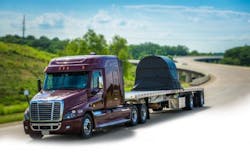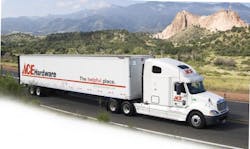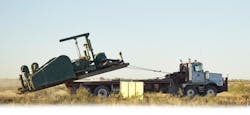2014 Fleet of the Year Awards
What the three winners of our 13th Annual Fleet of the Year Awards honored on the following pages (one each drawn from the for-hire, private and vocational segments of trucking) hold in common are top executives who strive to think outside the box.
Fleet Owner honors these outstanding trucking operations as exemplars of how to continually apply innovative thinking, both to surmount operational roadblocks and advance business results.
The mission these fleets carry out and the challenges they face widely differ. Yet they share a similar vision of what it takes to succeed in trucking today. They have bettered their operations not by relying on what worked in the past, nor by being constrained by what conventional wisdom preaches. These fleets stand out because their managers are leaders wide open to looking at every possible way to attain positive results for their company and its customers.
Nominations are not sought for these honors. Nor are they linked to any industry association or influenced by any outside group. Rather, candidates are identified and researched over the course of the calendar year by Fleet Owner’s editors, who then determine the Fleet of the Year winners.
In short, each of our honorees exemplifies the innovative leadership that we are proud to salute each year with our Fleet of the Year Awards.
For-Hire
Maverick Transportation, North Little Rock, AR
True to the name pinned on it like a badge of honor at the start, Maverick Transportation seeks to blaze its own trail by applying a “progressive mentality” to all things trucking.
“As the name implies, Maverick differentiates itself by taking a professional approach to everything that drives the flatbed, glass and temperature-controlled freight services, and logistics solutions we offer customers,” says president & COO Stephen Selig.
Founded in 1980 as a flatbed hauler by chairman & CEO Steve Williams, Maverick Transportation now provides transportation across several freight segments. It runs nearly 1,400 tractors and almost 2,000 trailers throughout the U.S. and Canada and also makes runs to Mexico.
While flatbed freight remains the truckload fleet’s bread-and-butter, it added a specialized glass-hauling division in 2006 and temperature control units in 2010. More recently, the company has invested in other specialized trailers to serve more niches, specifically on the dedicated side of its business.
The equipment operation, overseen by vice president of maintenance Mike Jeffress, handles over 60% of the fleet’s maintenance in-house. That work is accomplished in five service locations by a team of 122, including techs, administrative staff and managers.
“We made a commitment to safety a long time ago,” remarks Selig. “It starts with the truck and the technology we put on it, such as automated transmissions, electronic driver logs, and collision-avoidance and roll-stability-control systems. Then, during driver orientation and training as well as later through predictive analysis of their performance, we stress that our expectation is they will operate safely at all times.”
Maverick employs 1,196 company drivers and all but 16 of the 98 owner-operators it contracts with had been on the payroll before opting into tractor lease-purchase plans.
“Our approach to drivers is to stress honesty,” states Selig. “We do not make promises we can’t keep, but we do commit to helping drivers be successful here.”
He notes that the turnover rate for the year stands at 70%. He says that’s “a little higher than last year, but that number would be closer to 55% if drivers, mainly students with new CDLs who didn’t complete our extensive training program, were taken out.”
Determined to tackle the driver issue from a fresh angle this year, Maverick got to thinking so far outside the box, it left the box behind. Instead of continuing to see the driver shortage as a tough problem to solve, Maverick’s executives made the leap to envisioning the fleet as a comprehensive “part of the solution”—which they contend is to remake truck driving as “a career of choice, not one of last resort.”
The physical embodiment of this innovative thinking is the impressive expansion Maverick grafted onto its already remarkable driver-training center back in July.
Sited on Maverick’s corporate campus, the facility features both classrooms and training bays—in which newly hired drivers live-load all products hauled and learn the rigorous securement techniques required by the carrier.
Bearing a $4.5-million price tag, the 13,000-sq.-ft. addition smartly puts Maverick’s money square where its mouth is to help present truck driving as an attractive career choice. The expansion increased classrooms to seven and training bays to eight, effectively doubling the number of students that Maverick can train at any one time to 210.
The structure’s gleamingly modern design by Polk Stanley Wilcox, which incorporates products hauled by Maverick such as steel, lumber and glass, make it visually inviting to drivers. “This is where our drivers start their career with Maverick and that says a lot,” remarks vice president of safety & training Dean Newell.
Maverick also wanted the structure to be environmentally responsible, so it was built with such energy-savers as custom louvers to filter sunlight and automatic lighting throughout.
Investing yet more in its drivers this year, Maverick rolled out substantial increases in mileage pay. What’s more, these hikes were configured to benefit all incoming drivers, whether they arrived straight out of driving school or with a year or more of experience.
Private Fleet
Ace Hardware Corp., Oak Brook, IL
Looking to pool their buying power, four owners of Chicago hardware stores linked up 90 years ago to form Ace Hardware. Structured as a cooperative since 1973, Ace is owned entirely by its retailers who now operate more than 4,900 stores in over 60 countries.
Ace credits its history of retail success to customizing each store to best serve its local customers. That’s no mean feat. Not when anyone who walks into a hardware store anywhere expects it to have exactly what they came in for, each and every time.
So that only satisfied customers will walk out of any of the over 4,100 Ace stores in the Lower 48, the cooperative runs a sophisticated distribution network. It’s comprised of 14 retail support centers (RSCs), two import redistribution centers, six cross docks, and a nationwide private fleet charged with getting product from the RSCs to the stores safely, securely and on time. The fleet also backhauls freight to fill otherwise empty trailers.
Tom Grove, corporate delivery services manager, oversees the traffic departments within each RSC and manages the private fleet of 416 leased tractors and 1,200 owned or leased trailers. The Ace trucks are piloted by 500 company drivers whose tenure averages roughly 10 years.
“Vendors deliver their product and our private-label merchandise to the RSCs,” explains Grove. “From there, it’s typically a three-day process to complete a single store delivery. Each store has specific order and delivery days, which provides the basis for the routing of our trucks.
“However,” he continues, “because the fleet operates as a profit center, we backhaul product to the RSCs and haul freight for outside customers as well.” Grove credits this effort with cutting back empty miles “significantly” as well as helping the fleet hit its profit targets.
The private fleet’s managers and drivers alike have their work cut out for them. They must ensure the inventory for all those uniquely stocked Ace Hardware shops located across the country is replenished accurately and efficiently, again and again. Indeed, the average Ace store can build a delivery order by selecting from some 75,000 items.
Ace trucks head out cubed out with about 24,000 lbs. of merchandise. The average run covers 550 mi. Each truck rolls up around 100,000 mi. a year for a fleet total of 43 million mi. annually.
Drivers typically complete three to five routes a week, each having three to four stops. “We slip-seat drivers where we can,” points out Grove. “Some routes can be completed in a day while others are overnight runs. While some drivers are out two to three nights a week, having 14 RSCs limits time away from home.”
Ace upped equipment utilization by 10% via a year-long campaign to re-work routes. “Our routes are basically static,” Grove explains. “We purchased a system to optimize them on a one-time basis over the course of a year. That enabled us to eliminate unnecessary miles and to ‘rightsize’ our fleet. Going forward, we’re looking at additional software capabilities we can use to further boost efficiencies.”
Technology is also leveraged onboard. “In 2012, we finished rolling out the Omnitracs MCP110 mobile computer to all our trucks,” says Grove. “We use it to electronically manage hours-of-service compliance, track mpg and idling performance, and record such critical driving events as hard braking, excessive speeding and vehicle stability.
“As we can’t be there with our drivers, the system lets us see if they are encountering any problems out on the road,” he continues. “If there are, we can contact drivers about what actually happened and then determine if a given situation was an isolated incident or if remedial training is needed.”
Data collected is incorporated into Ace’s driver-performance review process. “Having an open dialog with drivers improves their satisfaction with the job,” Grove contends. “Without proper feedback, all they may hear is when someone voices a concern over something they may have done.
“How we interact with our drivers is critical to delivering customer service,” he adds. “Every day, they deliver on the Ace brand promise of being helpful.”
Vocational Fleet
Wilbanks Energy Logistics, Artesia, NM
Founded by Ronnie Wilbanks over 25 years ago in his backyard, Wilbanks Energy Logistics has evolved into an impressive provider of everything from rig mobilization and crane operation to equipment and pipe rental for companies laboring in the vast Permian Basin “oil patch” that stretches from southeastern New Mexico well into West Texas.
“The work that goes on in the oil patch has remained pretty much the same over the years,” says COO Lance Wilbanks, who’s Ronnie’s son. “What we’re doing now is applying cutting-edge technology to serving our customers operating out there.”
Wilbanks runs 120 highly specialized vehicles out of four terminals in Artesia, Carlsbad and Hobbs (NM) and Midland/Odessa (TX) to serve customers working in the dirt throughout the Permian Basin.
“Our vehicles are designed to haul oil-field equipment from site to site across New Mexico and Texas, running within 150 mi. of each of our terminals,” relates Wilbanks. “Every permitted load we carry is overweight and oversized. And we operate in open, mostly desert country, with our trucks running at least 30% of the time over unmaintained dirt roads.”
Wilbanks smartly applies technology to route what are often complex and challenging equipment movements from one point in the Permian Basin to another. Assisting with that is software that generates a map of each planned route so that obstacles and hazards to oversized loads can be spotted and worked around in advance.
Most of the tractors are Western Star 4900 models. Spec’d to haul 120,000- to 140,000-lb. loads, they’re fitted with winches to disassemble, load and unload, and reassemble oil rigs. The double- and triple-frame heavy haulers are powered by Detroit DD15 500-hp. engines that are run through Allison automatic transmissions. The fleet’s Scona and Kalyn-Siebert flatbed trailers include two-axle 48-ft. units and five-axle low boys, which are rated for loads up to 80 tons.
Obviously, the equipment gets run hard. Wilbanks points out that “dust is a big challenge, so we check air filters weekly and we must service brakes fairly frequently.” Most maintenance is accomplished in-house by a staff of 25 who work out of shops located at each company terminal.
Given the unique equipment they will pilot, drivers coming onboard must meet high standards. “Even an experienced over-the-road driver may need to go through 6 to 12 months of our specialized training before being assigned to some of our vehicles,” says Wilbanks.
“Superior drivers and equipment operators are critical to delivering customer value,” he continues. “To attract and retain the best in the business, we offer industry-leading wages and benefits and we stress that we operate safely.”
Indeed, Wilbanks regards safety performance as critical to the company’s success. “We’ve developed industry-leading safety processes and a comprehensive training program that goes above and beyond others to ensure our employees and equipment work safely at all times,” he points out.
Because many oil-field exceptions were discontinued when the new hours-of-service rules took effect last year, the company developed a proprietary dispatch system tuned to its specific needs. Wilbanks says the in-house solution “optimizes schedules for us. It manages hours both when drivers are on job sites—where they spend most of their time—and when they’re on the move.
“It took about a year to put together the dispatch system,” he continues. “Four to five years ago, we were scheduling on a notebook pad—figuring it out going just by a driver’s general mileage and what the job required. Now, our system provides the solution based on truck location and driver hours available for completing the job. In addition, we continually capture job-completion data to enhance how the system functions.
“We’re installing a tablet-based device for hours of service,” he adds. “It will tie into our dispatch system and save our drivers 20 to 30 minutes a day filling out paper logs.
“Our immediate focus is on the logistics expertise and the specialized equipment and personnel required for every job,” sums up Wilbanks. “But we also make sure we’re always looking for ways to further improve what we provide our customers.”



